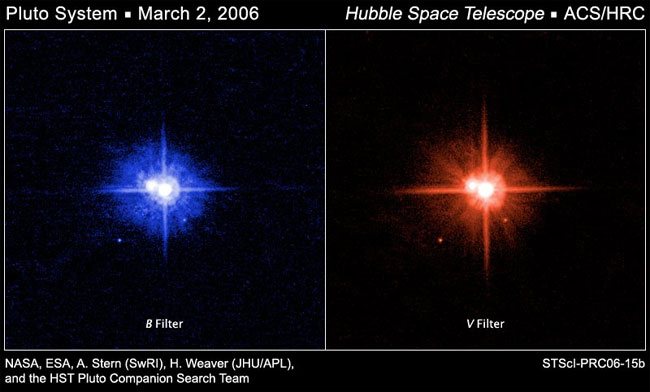Hubble Finds Pluto's Moons Less Than Colorful

The color of Pluto's two recentlydiscovered satellites are essentially the same neutral color as Pluto'slarge moon, Charon, scientists said Friday.
Charon's surface is known to consist primarily of waterice, so the similarcolors of P1 and P2 suggests that these moons have water ice surfaces, too.
The findingsupports the theory that all three of Pluto'smoons were formed from a single giantimpact that took place about 4.6 billion years ago. Recent observationsabout the orbitalmotions of Pluto's recently discovered moons, P1and P2, also support this theory.
"Everythingnow makes even more sense," said Alan Stern of the Southwest ResearchInstitute (SwRI). "If all three satellitespresumably formed from the same material lofted into orbit around Pluto from agiant impact, you might well expect the surfaces of all three satellites tohave similar colors."
Stern,principal investigator for NASA's NewHorizons mission currently headed toward Pluto, and colleague Hal Weaver ofJohns Hopkins University's Applied Physics Laboratory, ledthe research team that identified the color of the distant planet'snew found moons using the Hubble Space Telescope. The finding was announcedearlier this month.
The teamfound that P1 and P2 have essentially the same color as Charon'ssurface. The surfaces of all three moons reflect sunlight with equal efficiencyat all wavelengths; this property also applies to Earth's moon.
Pluto'ssurface, in contrast, has a reddish hue, which is believed to be the resultof interactions between sunlight and nitrogen and methane surface ices.
Breaking space news, the latest updates on rocket launches, skywatching events and more!
The findingwas detailed in a recent International Astronomical Union Circular (IAUC), ascientific newsletter which details recent astronomical discoveries.
- Pluto Might Have Rings
- Two More Moons Discovered Orbiting Pluto
- Pluto Colder Than Expected
- Observations Show Frigid Charon Has Had Some Hot Times
- Reaching for the Edge: New Horizons Spacecraft Bound for Pluto
Ker Than is a science writer and children's book author who joined Space.com as a Staff Writer from 2005 to 2007. Ker covered astronomy and human spaceflight while at Space.com, including space shuttle launches, and has authored three science books for kids about earthquakes, stars and black holes. Ker's work has also appeared in National Geographic, Nature News, New Scientist and Sky & Telescope, among others. He earned a bachelor's degree in biology from UC Irvine and a master's degree in science journalism from New York University. Ker is currently the Director of Science Communications at Stanford University.
